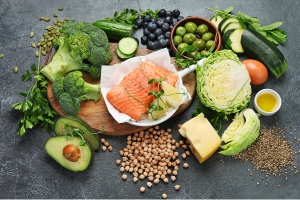Hi, I’m Laura. When I got my Type 2 Diabetes and high blood pressure diagnosis, the first thing I felt was… trapped. My doctor handed me a list of “don'ts,” and it felt like all the joy was about to be stripped from my kitchen.
I mean, as a busy mom of three, food is our family's love language! I was terrified I'd be stuck eating bland, boring meals forever.
But here's the truth I learned after years of deep-diving into the research (my Comp Sci background taught me how to sift through data) and a lot of trial-and-error in my own kitchen: Freedom isn't about a list of “bad” foods.
Freedom is understanding all the amazing, delicious foods you can have. It's about building a plate that you love, that your family will eat, and that keeps your blood sugar stable. That, to me, is the real diabetes freedom food list.
So, let's break down the entire plate, category by category. This is how I build my meals every single day.
Category 1: Non-Starchy Vegetables (The “Eat Freely” List)

This is your new best friend. Seriously. This is the one category that comes closest to “unlimited foods for diabetics.”
Why? Because they are packed with fiber and water, and have very few carbohydrates. This means they fill you up without spiking your blood sugar[2].
My rule, based on the American Diabetes Association (ADA) “Plate Method,” is simple: Fill half your plate with these guys. Every single meal.[1]
My Go-To Non-Starchy Veggies:
- Spinach & Leafy Greens (kale, arugula)
- Broccoli & Cauliflower
- Bell Peppers (all colors!)
- Cucumbers & Celery
- Zucchini & Yellow Squash
- Mushrooms
- Green Beans
- Tomatoes
- Onions & Garlic
My Practical Mom-Tip: I “hide” these everywhere. I finely chop spinach and mushrooms into my husband Mark's chili, I serve my own spaghetti sauce over a bed of zucchini noodles, and I always have a big, pre-chopped salad in the fridge for a quick lunch.
Category 2: Lean Protein (The “Feel Full” Foods)

Protein is crucial. It helps you feel full and satisfied, and it generally has a very minimal effect on your blood sugar. This is what stops those carb cravings later![1]
You want to fill one-quarter of your plate with a lean protein source.
Smart Protein Choices:
- Poultry: Chicken breast and turkey (skinless).
- Fish: Salmon, cod, tilapia, and tuna. Salmon is a rockstar for its heart-healthy Omega-3 fats, which is a huge bonus for those of us (like me!) managing high blood pressure.[3]
- Eggs: A cheap, easy, and fantastic source of protein.
- Plant-Based: Tofu, tempeh, and edamame.
A Quick Note on Beans & Lentils:
I love black beans and lentils! They are packed with fiber and protein. BUT (and this is a critical point!) they are not just protein. They are also a carbohydrate source[2]. I count them in my “Carb” category, which we'll get to in a minute.
Category 3: Healthy Fats (The “Flavor” Foods)

Fat is not the enemy! I spent years thinking “fat-free” was the healthy choice, and I was so wrong. Healthy fats are essential for feeling full and for absorbing certain vitamins. Plus, they don't raise your blood sugar.
The key is choosing healthy fats (monounsaturated and polyunsaturated) over saturated and trans fats, just as the USDA guidelines recommend.[4]
My Favorite Healthy Fats:
- Avocado
- Olive Oil (for salads and low-heat cooking)
- Avocado Oil (for high-heat cooking)
- Nuts (almonds, walnuts, pecans) – in moderation, as they are calorie-dense!
- Seeds (chia, flax, pumpkin)
A little goes a long way. A sprinkle of nuts on my salad, a quarter of an avocado with my eggs, or cooking my veggies in olive oil is all it takes.
Category 4: Fruits (The “Handle with Care” Sweets)

Yes, you can absolutely eat fruit! It's full of vitamins and fiber.[5] But it's also nature's candy, meaning it's a source of natural sugar (carbs).
The secret is portion control and choosing high-fiber, low-glycemic fruits.
My “Go-To” Fruits:
- Berries: Strawberries, blueberries, raspberries. These are my #1 pick. They're low in sugar, high in fiber, and packed with antioxidants.
- Apples & Pears: (With the skin on for fiber!)
- Melon: Cantaloupe and honeydew.
My practical tip: I always pair my fruit with a protein or fat. An apple with a small handful of almonds, or berries with a scoop of plain Greek yogurt. This “buffers” the sugar and prevents a sharp spike[7].
Many of these are featured in my guide to the Top 10 Superfoods for Diabetics. Avoid fruit juices and dried fruit, which are like sugar bombs[6].
Category 5: Grains & Starches (The “Portion is Everything” Carbs)

This is the final one-quarter of your plate. This was the hardest category for me to re-learn. I'm a mom, we run on quick carbs! But this is where blood sugar management is won or lost.
The goal is to choose complex, whole grains over refined “white” stuff. The fiber in whole grains slows down their conversion to sugar[8].
Smart Carb Choices (in small portions!):
- Quinoa
- Barley
- Oats (steel-cut or rolled, not the sugary packets)
- Sweet Potatoes
- Brown Rice
- Legumes (Beans, Lentils, Chickpeas)
This is where my low-carb pantry essentials list really comes into play. I keep these stocked so I can easily make a smart choice instead of reaching for white pasta.
An Important Safety Warning (Please Read This)
Okay, friend to friend, let's be 100% clear. This is crucial.
Even “free” foods like non-starchy vegetables have some calories and carbs. The ADA's definition of a “free food” is a serving with less than 20 calories and 5 grams of carbs[9]. If you eat 3 cups of broccoli, you do need to count those carbs.
This advice is NOT for everyone. You MUST talk to your doctor.
- If you are on insulin or other blood-sugar-lowering medications: Making a big change to your diet (even a “healthy” one!) can drastically change your medication needs. You could be at risk for hypoglycemia (low blood sugar), which is dangerous. Do not make changes without medical supervision[10].
- If you have other conditions: If you have kidney disease, you may need to limit protein or certain minerals found in these foods[11].
I am a researcher and a coach sharing what worked for my T2D and high blood pressure. I am not a doctor or dietitian.
My Final Thoughts on True Food Freedom
Here's the bottom line: Building your plate this way is liberating. You stop thinking “I can't have that” and start thinking “How can I build my plate?”
- Start with half a plate of veggies.
- Add a quarter plate of lean protein.
- Add a quarter plate of smart carbs.
- Use healthy fats for flavor.
This balanced approach is the most sustainable, family-friendly way I've found to manage my diabetes and still love my food. For a complete A-to-Z list, you might find my Ultimate Diabetic Food List helpful.
What's the one food category you struggle with the most? Or what's a “free food” you've learned to love? Let me know in the comments below! We're all in this together.
Disclaimer: This article is for informational and educational purposes only, based on my personal research and experience. It does not constitute medical advice. Always consult with your doctor or a qualified healthcare provider before making any significant changes to your diet or health routine.
References
- American Diabetes Association. Plan Your Plate (Diabetes Plate Method), 2025. ↩︎ Back to text
- American Diabetes Association. Carbs and Diabetes (Understanding Carbs). ↩︎ Back to text
- American Heart Association. 2021 Dietary Guidance to Improve Cardiovascular Health. ↩︎ Back to text
- Dietary Guidelines for Americans 2020–2025: Cut Down on Saturated Fat (replace with unsaturated). ↩︎ Back to text
- American Diabetes Association. Best Fruit Choices for Diabetes. ↩︎ Back to text
- CDC. Choosing Healthy Carbs — Eat whole fruits instead of juice (limit juice/dried fruit). ↩︎ Back to text
- CDC. Meal Planning for Diabetes — Tips to reduce blood sugar spikes (pair carbs with protein/fat/fiber). ↩︎ Back to text
- Hu Y. et al. Intake of whole grain foods and risk of type 2 diabetes. BMJ. 2020. ↩︎ Back to text
- University of Iowa Health Care. Diabetes and Carb Counting — Free foods definition (<20 kcal and ≤5 g carbs). ↩︎ Back to text
- American Diabetes Association. Standards of Care in Diabetes—2025: Section 6 (Glycemic Goals and Hypoglycemia). ↩︎ Back to text
- American Diabetes Association. Standards of Care in Diabetes—2025: Section 11 (Chronic Kidney Disease and Risk Management). ↩︎ Back to text








12 Responses
I’m excited about all the vegetable suggestions, but I’m a terrible cook! I don’t have a lot of time to spend in the kitchen. Are there any easy ways to prepare these vegetables without complicated recipes?
Hi Jessica, I hear you! Cooking doesn’t have to be complicated. One of the easiest ways to enjoy vegetables is to roast them. Simply chop up your favorite veggies (broccoli, carrots, bell peppers, etc.), toss them with a little olive oil, salt, and pepper, and roast them in the oven at 400°F (200°C) until tender. You can also steam or microwave vegetables for a quick and healthy side dish. And, of course, enjoying raw vegetables with a healthy dip is always a great option!
I’m trying to eat healthier, but I have a sweet tooth. It’s hard to resist desserts. Are there any fruits that are better than others for satisfying a sweet craving without spiking my blood sugar?
Hi Ashley, I understand the struggle with sweet cravings! Berries are a great choice for satisfying your sweet tooth while being relatively low on the glycemic index. Blueberries, raspberries, and strawberries are all good options. You can also try a small piece of fruit with a handful of nuts or a dollop of Greek yogurt to help slow down sugar absorption and keep you feeling full longer. Remember that even with fruit, portion control is important.
This article is encouraging! It’s nice to see a focus on what you can eat rather than just what you should avoid. My concern, however, is the emphasis on ‘enjoying without restriction.’ While the article mentions portion control for fruits and whole grains, it seems to imply you can eat unlimited amounts of vegetables and lean protein. Is that really the case? Could overeating even these ‘good’ foods still impact blood sugar or weight management?
Hi Elizabeth, thanks for your thoughtful question! You’re absolutely right to question the phrase ‘without restriction.’ While vegetables and lean protein are incredibly beneficial and generally have a minimal impact on blood sugar compared to carbohydrates, the concept of ‘unlimited’ intake should always be approached with caution.
Even with healthy foods, overeating can lead to weight gain, which can indirectly affect blood sugar control. While non-starchy vegetables are very low in calories and carbohydrates, consuming excessive amounts could still contribute to overall calorie intake. Similarly, while lean protein is crucial, consuming very large quantities could potentially impact kidney function for some individuals, especially those with pre-existing kidney conditions.
The key takeaway is balance and moderation. Focus on incorporating plenty of vegetables and lean protein into your diet, but be mindful of your overall portion sizes. The plate method, mentioned in previous articles, provides a good visual guide for creating balanced meals. It’s always best to listen to your body’s hunger and fullness cues. Thank you for pointing out this important nuance!
This article mentions the glycemic index (GI) for fruits, which is helpful. I’m wondering if there’s a similar system for other food groups, like vegetables or grains? It would be great to have a clearer understanding of how different types of vegetables or grains impact blood sugar levels. Also, you mentioned pairing fruits with protein or healthy fats. Could you give some specific examples of good pairings?
Hi Jessica, thanks for your excellent questions! Yes, there is a similar system for other food groups called the Glycemic Load (GL). While the GI measures how quickly a food raises blood sugar, the GL takes into account the portion size of the food. This makes the GL a more practical tool for everyday meal planning. You can find online resources that list the GI and GL values for various foods, including vegetables and grains.
In general, non-starchy vegetables have a low GI and GL, meaning they have a minimal impact on blood sugar. Whole grains tend to have a lower GI and GL than refined grains.
As for pairing fruits with protein or healthy fats, here are a few examples:
Apple slices with almond butter: The fiber in the apple and the healthy fats and protein in the almond butter help slow down sugar absorption.
Berries with Greek yogurt: The protein in the Greek yogurt helps to balance the natural sugars in the berries.
Pear with cheese: A small piece of cheese provides protein and fat, which can help prevent a blood sugar spike after eating the pear.
Avocado with a small piece of fruit: The high healthy fat content of avocado helps to slow down the digestion and absorption of sugars from the fruit.
These pairings are a great way to enjoy the natural sweetness of fruit while keeping your blood sugar levels stable. Thanks for your insightful questions!
This all sounds great in theory, but ‘foods you can enjoy without restriction’? Come on, let’s be real. I have type 2 diabetes, and I feel like I’m constantly counting carbs and watching portions. It’s exhausting! Is this article seriously suggesting I can just eat as much broccoli and kale as I want? And what about fruit? I love fruit, but I’ve always been told it’s basically like candy because of the sugar. I’m confused and a little skeptical.
Hey Megan, thanks for keeping it real! I totally understand your skepticism. The title might sound a bit too good to be true, but the key is understanding the types of foods we’re talking about. Non-starchy veggies like broccoli and kale are packed with fiber and nutrients but are super low in carbs, so you can generally eat a good amount of them without sending your blood sugar on a roller coaster. Think of them as your freebies!
As for fruit, you’re right to be mindful. It does contain natural sugars, but it also has fiber, which helps slow down sugar absorption. The article highlights lower-GI fruits like berries, which have a gentler impact on blood sugar. It’s all about portion control and maybe pairing fruit with some protein or healthy fat to keep things balanced. It’s not about unlimited fruit, but it’s definitely not off-limits either. It is always best to test your blood sugar after eating certain foods to see how they affect you.
Think of it this way: It’s not about restriction, it’s about making informed choices. This article is meant to empower you with knowledge, not to suggest you can eat a whole watermelon in one sitting! Does that make a bit more sense?
Okay, I’m intrigued by the whole grains part. I’ve always been a little scared of carbs, even the ‘good’ ones. But I’m getting so tired of salads and grilled chicken. Are we really saying that things like quinoa and brown rice are okay for someone with diabetes? And what about bread? I miss bread! Also, ‘mindful eating’? Sounds a bit new-agey to me. How is that supposed to help my blood sugar? Sorry for all the questions, but I’m desperate for some practical advice that doesn’t involve living like a rabbit.
Hi Olivia, I love your questions! Carbs can be tricky, but whole grains are different from the refined stuff. They have fiber, which is like a superhero for blood sugar control – it slows down digestion and prevents those spikes. So yes, quinoa, brown rice, and even whole-wheat bread (in moderation and the right kind!) can definitely be part of a healthy diabetic diet. The key is to watch your portions and choose truly whole-grain options. Look for ‘whole wheat’ or ‘whole grain’ as the first ingredient on the label.
And about mindful eating – it might sound a bit ‘out there,’ but it’s actually super practical. It’s about paying attention to your body’s hunger and fullness cues, eating slowly, and really savoring your food. This can help you avoid overeating and make better food choices overall, which is a win for blood sugar management. Think of it as a way to tune into your body’s signals instead of eating mindlessly in front of the TV (we’ve all been there!). It’s not about being perfect, it is about making small changes.
You don’t have to live like a rabbit, Olivia! There’s a whole world of delicious, diabetes-friendly foods out there. It’s all about finding a balance that works for you and helps you enjoy your food while keeping your blood sugar happy. I hope this helps!